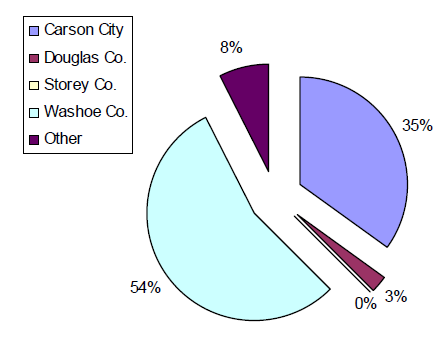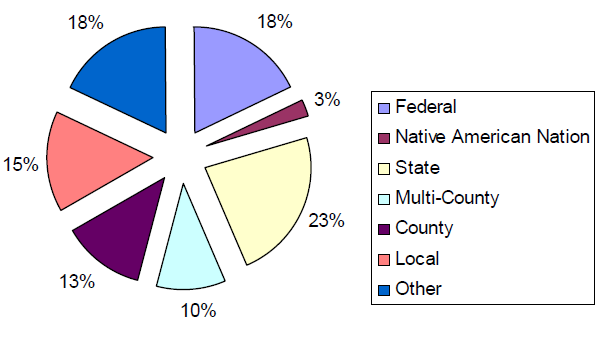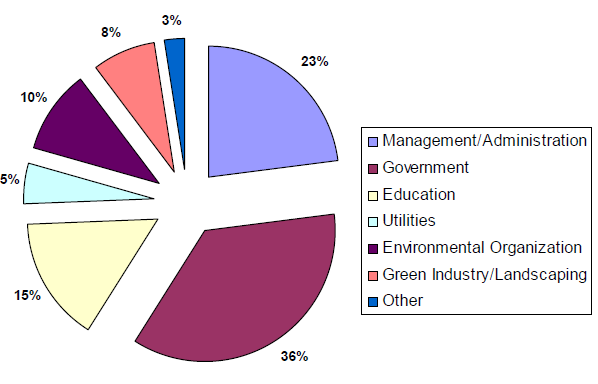Introduction
Clean water is essential for life. Beyond the need for safe drinking water supplies, however, is the need for clean water to maintain agricultural production, recreational uses, fisheries and wildlife habitat, industrial uses and a healthy Nevada economy.
The Nevada 2004 303(d) Impaired Waters List shows that every major lake and river in Nevada suffers from some level of water quality impairment, including contamination by nutrients, metals, sediment, temperature, total dissolved solids, pH and additional pollutants (NDEP, 2005). Groundwater supplies are contaminated with pesticides, industrial chemicals, nitrates and bacteria from septic systems and livestock waste, and arsenic and other geologic constituents.
Numerous past studies have identified the issue of water quality as a major concern in the Western Area of University of Nevada Cooperative Extension, which includes Douglas, Storey and Washoe Counties and Carson City municipality. A natural resources needs assessment completed in 1999 identified “water quality” as one of nine pressing issues (Carlos et al., 1999). A horticulture needs assessment completed in 2003 (unpublished data) again identified the issue of “water quality.” More recently, a statewide survey of agricultural producers (Singletary, 2006) and of Lake Tahoe stakeholders (Kocher and Cobourn, 2007) also identified this issue.
Additional clarification of specific issues related to water quality is helpful in strategic planning of future educational programs and priorities. This study invited stakeholders to rank specific water quality issues that will challenge the Western Area of Nevada during the next five years.
Methodology
Using a modified Delphi approach, a list of 54 water quality-related issues was developed. Input was received from key stakeholders including hydrologists, water planners, utilities managers, engineers, landscapers, tribal interests, conservationists and regulators. Issues were grouped into the following categories:
- General water quality issues
- Issues related to stormwater runoff
- Issues related to waste disposal and hazardous materials
- Issues related to construction and development
- Issues related to homeowner practices
- Issues related to agriculture
- Issues related to riparian condition
- Other issues
An online survey was developed using a Webbased survey company. An email link to the survey was sent to 68 key informants in the Western Area of Nevada. Respondents were asked to rate the issues on a scale from 1, least important, to 9, tremendously important, by focusing on water quality needs and issues in the Western Area during the next five years. Respondents were also invited to write in issues that were not listed in the survey. Specific issues are presented in Appendix 1.
Results were ranked by weighted scores using the rating scale from 1 to 9, and also by the number of respondents ranking the issue as 9, or “tremendously important.” There were minor differences in the results from the two methods.
Results
The survey response rate was 57% (n=39). Most respondents were housed in Carson City or Washoe County, reflecting the number of state and federal employees working in Carson City (Figure 1). No respondents were housed in Storey County, and only 3% were housed in Douglas County.
Figure 1. County Housing Respondents’ Office

| County |
Percentage |
| Carson City |
35% |
| Douglas Co. |
3% |
| Storey Co. |
0% |
| Washoe Co. |
54% |
| Other |
8% |
Respondents were fairly evenly distributed among those with federal, state, county and local responsibilities (Figure 2). The single largest occupation category was government, followed by management/ administration (Figure 3).
Figure 2. Level of Respondents’ Job Responsibilities

| Category |
Percentage |
| Federal |
18% |
| Native American Nation |
3% |
| State |
23% |
| Multi-County |
10% |
| County |
13% |
| Local |
15% |
| Other |
18% |
Figure 3. Respondents’ Occupation Category

| Category |
Percentage |
| Management/Administration |
23% |
| Government |
36% |
| Education |
15% |
| Utilities |
5% |
| Environmental Organization |
10% |
| Green Industry/Landscaping |
8% |
| Other |
3% |
The top 10 issues based on the weighted scores clustered on the issues of tributary and riparian condition (1, 2, 5, 8, 9); impacts related to growth and changes in land use (4, 10), insufficient watershed protection planning (3, 6), and invasive species infestations (7) (Table 1). Ranking of themes by the average of weighted scores for associated issues revealed three themes weighted the highest: issues related to riparian condition, storm water runoff, and construction and development (Table 2). The theme “issues related to agriculture” was weighted lowest.
The top 10 issues based on the number scoring an issue as “tremendously important” also clustered on the issues of tributary and riparian condition (1, 2, 8, 10); impacts related to growth and changes in land use (4, 6), insufficient watershed protection planning (4, 10), invasive species infestations (6), and groundwater contamination (8) (Table 3). Groundwater contamination was the only issue not appearing on the list of top 10 issues by weighted score. Complete lists of ranked and weighted issues are provided in Appendix 2 and Appendix 3.
Only five issues did not receive a single ranking as “tremendously important.” These include:
- Household hazardous chemical disposal
- Contamination of food products by waterborne agricultural wastes
- Water quality for crop irrigation
- Contamination from pet wastes
- Radon contamination
Eleven respondents wrote in additional issues they felt were very important. These were grouped into the following topics:
- Economic impacts of water quality decisions
- Wastewater issues, including effluent reuse, effluent impacts on aquatic life, and inconsistent wastewater treatment requirements
- Drinking water quality, including arsenic and uranium standards, and persistent organic pollutants
- The need to base water quality decisions on water quality data measurements
- Community ownership in water quality issues
- Political leadership responsibilities in planning (to protect water quality)
Table 1. Top 10 issues based on the weighted score
| Ranking |
Issue |
Weighted Score |
| 1 |
Stream habitat degradation |
7.744 |
| 2 |
Riparian degradation |
7.718 |
| 3 |
Degradation of tributary watersheds |
7.718 |
| 4 |
Urban sprawl impacts |
7.590 |
| 5 |
Nonfunctioning riparian condition |
7.513 |
| 6 |
Insufficient watershed protection planning |
7.436 |
| 7 |
Invasive species infestations |
7.359 |
| 8 |
Degradation of tributaries |
7.359 |
| 9 |
Degradation of fisheries |
7.333 |
| 10 |
Water quality impacts related to changes in land use |
7.308 |
Table 2. Ranking of grouped themes by average weighted score
| Ranking |
Grouped Theme* |
Weighted Score |
| 1 |
Related to riparian condition |
7.282 |
| 2 |
Related to storm water runoff |
6.868 |
| 3 |
Related to construction and development |
6.795 |
| 4 |
Related to homeowner practices |
6.046 |
| 5 |
Related to waste disposal and hazardous materials |
5.826 |
| 6 |
Related to agriculture |
5.446 |
| *No average weighted score was assigned to “general issues” or “other issues.” |
Table 3. Top 12 issues based on the number scoring an issue as “tremendously important”
| Ranking |
Issue |
Number of Respondents Scoring Issue as “9” |
Percent of Respondents Scoring Issue as “9” |
| 1 |
Riparian degradation |
18 |
46.20% |
| 2 |
Stream habitat degradation |
17 |
43.60% |
| 3 |
Nonfunctioning riparian condition |
17 |
43.60% |
| 4 |
Degradation of tributary watersheds |
15 |
38.50% |
| 5 |
Urban sprawl impacts |
15 |
38.50% |
| 6 |
Water quality impacts related to changes in land use |
14 |
36.80% |
| 7 |
Invasive species infestations |
14 |
35.90% |
| 8 |
Degradation of tributaries |
13 |
33.30% |
| 9 |
Groundwater contamination |
13 |
33.00% |
| 10 |
Insufficient watershed protection planning |
12 |
31.60% |
| 11 |
Degradation of fisheries |
12 |
30.80% |
| 12 |
Changes in stream geomorphology |
12 |
30.80% |
Summary and Limitations
Ranking of water quality issues in the Western Area reveals a perceived need for protection of tributary streams and their watersheds. Limitations to the study include the low response rate (57%); poor response from Douglas and Storey Counties; and lack of self identification with agriculture as an occupation. In addition, it is impossible to decouple issues of water quality from issues of water quantity. For example, agricultural diversions often lower flow rates dramatically, making attainment of aquatic life standards difficult or impossible. However, this issue was not addressed by this study.
Results from this survey will be used with other sources of information in strategic planning for future programs and activities.
Citations
- Carlos, B., J. Cobourn, S. Donaldson, S. Lewis, E. Miller, D. Post, M. Rebori, J. Skelly and E. Smith. 1999. Natural Resource Needs in Western Nevada, University of Nevada Cooperative Extension SP-99- 01.
- Kocher, S. and J. Cobourn. 2007. Natural Resource Issues in the Lake Tahoe Basin (draft).
- Lewis, S. 2003. Community Needs Assessment: Douglas County 2002. University of Nevada Cooperative Extension SP-03-11.
- Nevada Division of Environmental Protection (NDEP). 2005. Nevada’s 2004 303(d) Impaired Waters List. Bureau of Water Quality Planning, NDEP.
- Singletary, L. and M. Smith. 2006. Nevada Agriculture Producer Research and Education Needs: Results of 2006 Statewide Needs Assessment. Educational Bulletin EB-06-02.
- USGS. 1999. Nutrients and Pesticides. USGS Circular 1225.
- USGS. 2006. Pesticides in the Nation’s Streams and Ground Water, 1992 – 2001. USGS Circular 1291.
- USGS. 2006. Volatile Organic Compounds in the Nation’s Ground Water and Drinking-Water Supply Wells. USGS Circular 1291.
Appendix 1
Grouping of Water Quality Issues for the Survey Instrument
General issues
- Groundwater contamination
- Wetland destruction
- Failure to meet regulatory limits such as Total Maximum Daily Loads (TMDLs)
- Water quality standards
- Insufficient watershed protection planning
- Increased levels of total dissolved solids
- Thermal pollution
- Geothermal discharges
- Drinking water quality impairment
- Flood-related water quality impairment
- Heavy metal contamination
- Mercury contamination
- Radon contamination
Related to stormwater runoff
- Polluted runoff from roads and parking lots
- Road salts and de-icers
- Contaminated, untreated stormwater
- Best Management Practices (BMPs) not appropriate to arid environment
- Water quality impacts related to changes in land use
- Urban sprawl impacts
Related to waste disposal and hazardous materials
- Household hazardous chemical disposal
- Hazardous materials spills
- Failing septic systems
- Leaking underground storage tanks
- Municipal wastewater discharges
- Contamination from landfills
- Mining wastes
- Improper disposal of wastes
- Fuel leakage from motorized watercraft
Related to construction and development
- Soil erosion from building or road construction
- Clearing of vegetation from construction sites
- Failure to install BMPs
- Improperly installed BMPs
- Failure to maintain BMPs
Related to homeowner practices
- Domestic well water quality impairment
- Domestic wellhead protection
- Pesticide contamination of surface and groundwater
- Fertilizer contamination of surface and groundwater
- Contamination from pet wastes
Related to agriculture
- Water quality for crop irrigation
- Manure management
- Contamination of food products by waterborne agricultural wastes
- Pesticide misuse
- Fertilizer misuse
Related to riparian condition
- Riparian degradation
- Nonfunctioning riparian condition
- Changes of stream geomorphology
- Degradation of fisheries
- Stream habitat degradation
- Impacts to recreational uses
- Degradation of tributaries
- Degradation of tributary watersheds
Other issues
- Timber harvesting
- Wildfire impacts
- Invasive species infestations
- Other (respondents write in their own issues)
Appendix 2: Issues Ranked by Weighted Score
| Issue |
Weighted Score |
| Stream habitat degradation |
7.744 |
| Riparian degradation |
7.718 |
| Degradation of tributary watersheds |
7.718 |
| Urban sprawl impacts |
7.590 |
| Nonfunctioning riparian condition |
7.513 |
| Insufficient watershed protection planning |
7.436 |
| Invasive species infestations |
7.359 |
| Degradation of tributaries |
7.359 |
| Degradation of fisheries |
7.333 |
| Water quality impacts related to changes in land use |
7.308 |
| Failure to maintain Best Management Practices (BMPs) |
7.077 |
| Changes in stream geomorphology |
7.051 |
| Wildfire impacts |
6.872 |
| Failure to install BMPs |
6.872 |
| Polluted runoff from roads and parking lots |
6.846 |
| Contaminated, untreated stormwater |
6.821 |
| Improperly installed BMPs |
6.795 |
| Fertilizer contamination of surface water and groundwater |
6.692 |
| Wetland destruction |
6.641 |
| Soil erosion from building or road construction |
6.641 |
| Domestic well water quality impairment |
6.615 |
| Clearing of vegetation from construction sites |
6.590 |
| Drinking water quality impairment |
6.590 |
| Groundwater contamination |
6.564 |
| Failing septic systems |
6.538 |
| Road salts and de-icers |
6.436 |
| Water quality standards |
6.333 |
| Domestic wellhead protection |
6.256 |
| Municipal wastewater discharges |
6.256 |
| Fertilizer misuse |
6.256 |
| BMPs not appropriate to arid environment |
6.205 |
| Pesticide misuse |
6.205 |
| Pesticide contamination of surface water and groundwater |
6.128 |
| Household hazardous chemical disposal |
5.974 |
| Leaking underground storage tanks |
5.897 |
| Hazardous materials spills |
5.897 |
| Improper disposal of wastes |
5.846 |
| Fuel leakage from motorized watercraft |
5.846 |
| Impacts to recreational uses |
5.821 |
| Failure to meet regulatory limits |
5.718 |
| Flood-related water quality impairment |
5.590 |
| Mercury contamination |
5.564 |
| Heavy metal contamination |
5.513 |
| Increased levels of total dissolved solids |
5.282 |
| Mining wastes |
5.205 |
| Manure management |
5.128 |
| Contamination from landfills |
4.974 |
| Contamination of food products by waterborne agricultural wastes |
4.872 |
| Water quality for crop irrigation |
4.769 |
| Thermal pollution |
4.718 |
| Contamination from pet wastes |
4.538 |
| Timber harvesting |
4.487 |
| Radon contamination |
4.436 |
| Geothermal discharges |
3.923 |
Appendix 3: Issue Ranking by Number of Respondents Scoring Issue as “Tremendously Important”
| Issue Rating (weighted) |
Number Scoring as “Tremendously Important” |
Weighted Score |
| Riparian degradation |
18 |
7.718 |
| Stream habitat degradation |
17 |
7.744 |
| Nonfunctioning riparian condition |
17 |
7.513 |
| Degradation of tributary watersheds |
15 |
7.718 |
| Urban sprawl impacts |
15 |
7.590 |
| Water quality impacts related to changes in land use |
14 |
7.308 |
| Invasive species infestations |
14 |
7.359 |
| Degradation of tributaries |
13 |
7.359 |
| Groundwater contamination |
13 |
6.564 |
| Insufficient watershed protection planning |
12 |
7.436 |
| Degradation of fisheries |
12 |
7.333 |
| Changes in stream geomorphology |
12 |
7.051 |
| Contaminated, untreated stormwater |
11 |
6.821 |
| Wildfire impacts |
10 |
6.872 |
| Polluted runoff from roads and parking lots |
10 |
6.846 |
| Failure to maintain Best Management Practices (BMPs) |
9 |
7.077 |
| Failure to install BMPs |
9 |
6.872 |
| Wetland destruction |
9 |
6.641 |
| Failing septic systems |
8 |
6.538 |
| Clearing of vegetation from construction sites |
8 |
6.590 |
| Improperly installed BMPs |
7 |
6.795 |
| Soil erosion from building or road construction |
7 |
6.641 |
| Water quality standards |
7 |
6.333 |
| Domestic wellhead protection |
7 |
6.256 |
| Fertilizer contamination of surface water and groundwater |
6 |
6.692 |
| Domestic well water quality impairment |
6 |
6.615 |
| Municipal wastewater discharges |
6 |
6.256 |
| Heavy metal contamination |
6 |
5.513 |
| Drinking water quality impairment |
5 |
6.590 |
| BMPs not appropriate to arid environment |
5 |
6.205 |
| Pesticide misuse |
5 |
6.205 |
| Mining wastes |
5 |
5.205 |
| Fertilizer misuse |
4 |
6.256 |
| Leaking underground storage tanks |
4 |
5.897 |
| Improper disposal of wastes |
4 |
5.846 |
| Fuel leakage from motorized watercraft |
4 |
5.846 |
| Failure to meet regulatory limits |
4 |
5.718 |
| Flood-related water quality impairment |
4 |
5.590 |
| Mercury contamination |
4 |
5.564 |
| Road salts and de-icers |
3 |
6.436 |
| Pesticide contamination of surface water and groundwater |
3 |
6.128 |
| Impacts to recreational uses |
3 |
5.821 |
| Hazardous materials spills |
2 |
5.897 |
| Increased levels of total dissolved solids |
2 |
5.282 |
| Manure management |
2 |
5.128 |
| Thermal pollution |
2 |
4.718 |
| Timber harvesting |
2 |
4.487 |
| Contamination from landfills |
1 |
4.974 |
| Geothermal discharges |
1 |
3.923 |
| Household hazardous chemical disposal |
0 |
5.974 |
| Contamination of food products by waterborne agricultural wastes |
0 |
4.872 |
| Water quality for crop irrigation |
0 |
4.769 |
| Contamination from pet wastes |
0 |
4.538 |
| Radon contamination |
0 |
4.436 |
Donaldson, S.
2007,
Ranking Water Quality Issues in Western Nevada,
Extension | University of Nevada, Reno, FS-07-14


